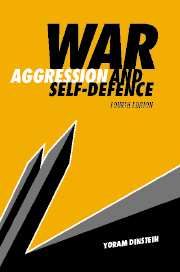Book contents
- Frontmatter
- Contents
- Introduction to the fourth edition
- From the introduction to the first edition
- Table of cases
- Table of treaties
- Table of security council and general assembly resolutions
- List of abbreviations
- Part I The legal nature of war
- Part II The illegality of war
- Part III Exceptions to the prohibition of the use of inter-state force
- 7 The concept of self-defence
- 8 The modality of individual self-defence
- 9 Collective self-defence
- 10 Collective security
- Conclusion
- Index of persons
- Index of subject
7 - The concept of self-defence
- Frontmatter
- Contents
- Introduction to the fourth edition
- From the introduction to the first edition
- Table of cases
- Table of treaties
- Table of security council and general assembly resolutions
- List of abbreviations
- Part I The legal nature of war
- Part II The illegality of war
- Part III Exceptions to the prohibition of the use of inter-state force
- 7 The concept of self-defence
- 8 The modality of individual self-defence
- 9 Collective self-defence
- 10 Collective security
- Conclusion
- Index of persons
- Index of subject
Summary
The right of self-defence
The meaning of self-defence
In its 1996 Advisory Opinion on the Legality of the Threat or Use of Nuclear Weapons, the International Court of Justice stated:
Furthermore, the Court cannot lose sight of the fundamental right of every State to survival, and thus its right to resort to self-defence, in accordance with Article 51 of the Charter, when its survival is at stake.
The implication is that the right of self-defence is engendered by, and embedded in, the fundamental right of States to survival. However, the Court itself acknowledged that ‘the very survival of a State would be at stake’ only ‘in an extreme circumstance of self-defence’. Extreme circumstances of self-defence – when the very survival of a State is imperilled – do arise from time to time, but the exercise of self-defence is by no means confined to such catastrophic scenarios. The reality of self-defence in inter-State relations is much more prosaic: it transcends life-or-death existential crises and impinges on a host of commonplace situations involving the use of counter-force.
The essence of self-defence is self-help: under certain conditions set by international law, a State acting unilaterally – perhaps in association with other countries – may respond with lawful force to unlawful force (or, minimally, to the imminent threat of unlawful force). The reliance on self-help, as a remedy available to States when their rights are violated, is and always has been one of the hallmarks of international law.
- Type
- Chapter
- Information
- War, Aggression and Self-Defence , pp. 175 - 218Publisher: Cambridge University PressPrint publication year: 2005
- 2
- Cited by



